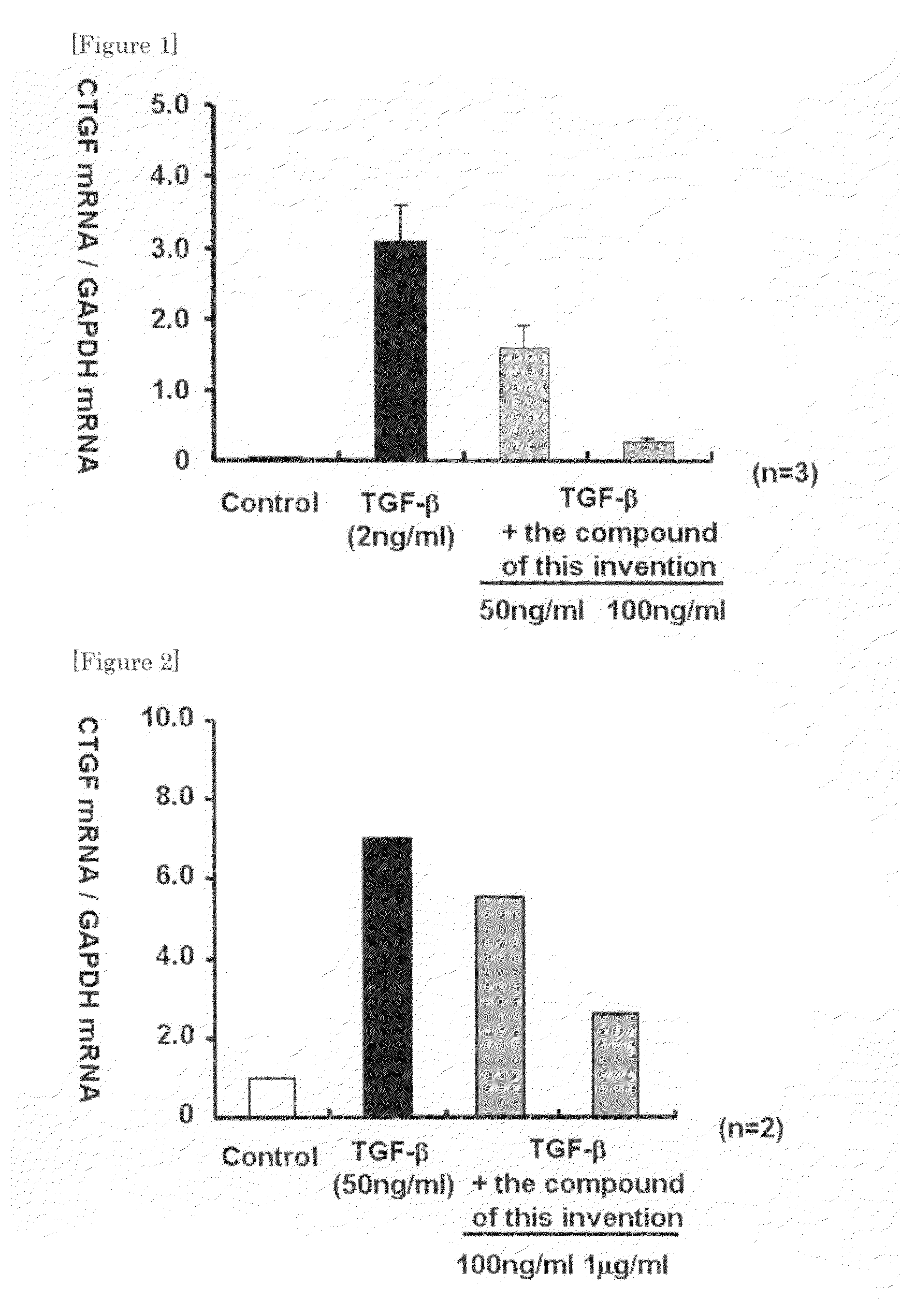Ctgf Expression Inhibitor
a technology of ctgf and expression inhibitor, which is applied in the field of ctgf expression inhibitor, can solve the problems that tgf-1 knockout mice cannot survive so long after birth, and the biological action of tgf- for a long time is difficult to adapt to clinical use, and achieves the effect of inhibiting the expression of ctg
- Summary
- Abstract
- Description
- Claims
- Application Information
AI Technical Summary
Benefits of technology
Problems solved by technology
Method used
Image
Examples
example 1
[0331]
Salicylanilide (3):
[0332]5-lodosalicylic acid (1) (2.43 g, 8.215 mmol) and m-trifluoromethylaniline (2) (1.49 g, 8.215 mmol) were added to chlorobenzene (50 ml). PCl3 (0.4 ml, 0.5 eq) was added, and the mixture was heated at 150° C. for 2 hours. Chlorobenzene was evaporated under reduced pressure and the resulting crystals deposited from diethyl ether were collected by filtration to give 3.06 g (82%) of a desired compound (3).
[0333]NMR(DMSO) δppm:6.85 (1H, dAB, J=6 Hz, Ar—H), 7.51 (1H, dAB, J=6 Hz, Ar—H), 7.62 (1H, dAB, J=6 Hz, Ar—H), 7.94 (1H, dAB, J=6 Hz, Ar—H), 8.18 (1H, dAB, J=6 Hz, Ar—H), 10.61 (1H, s, NH), 11.8 (1H, s, OH).
Mesylate (4):
[0334]The above amide derivative (3) (0.5 g, 1.23 mmol) was dissolved in tetrahydrofuran (10 ml). Triethylamine (0.24 ml, 1.4 eq) and methanesulfonyl chloride (0.13 ml, 1.4 eq) were added, and the mixture was reacted at room temperature for 30 minutes. The solution was added to ice water (70 ml), extracted twice with acetic acid ethyl este...
example 2
[0344]
Biphenyl Derivative (43):
[0345]The above iodide derivative (4) (250 mg, 0.515 mmol) was dissolved in dimethylformamide (5 ml). Boronic acid (42) (159 mg, 1.5 eq), PdCl2 (dppf) (159 mg, 0.15 eq) and potassium carbonate (214 mg, 3 eq) were added, and the mixture was reacted at 80° C. for 1 hour under N2 atmosphere. The reaction solution was added to ice water (50 ml), extracted twice with acetic acid ethyl ester (50 ml), washed three times with water (50 ml) and dried over anhydrous sodium sulfate. The residue obtained by evaporating the solvent under reduced pressure was purified by silica gel column chromatography (toluene-acetic acid ethyl ester=20−1) and the following recrystallization from n-hexane to give a desired product (43) 106 mg (50%).
[0346]The melting point: 200-202° C.
[0347]NMR (CDCl3) δppm:7.08(1H, dAB, J=6 Hz Ar—H), 7.28 to 7.66 (8H, m, Ar—H), 7.91 (1H, dAB, J=6 Hz, Ar—H), 8.00 (1H, s, Ar—H), 8.23 (1H, s, NH), 10.25 (1H, s, OH).
[0348]IRvmax (KBr):3156, 1637, 1614...
example 3
[0351]
Salicylamide Derivative (61):
[0352]4-chlorosalicylate (59) (1.08 g, 6.249 mmol) and 2-bromo-5-trifluoromethyl-aniline (60) (1.5 g, 6.249 mmol) were added to chlorobenzene (15 ml). PCl3 (0.27 ml, 0.5 eq) was added, and the mixture was heated at 150° C. for 2 hours. The residue obtained by evaporating the solvent under reduced pressure was purified by silica gel column chromatography (toluene-acetic acid ethyl ester=9−1) and the following recrystallization from n-hexane to give a desired compound (61) (2.02 g, 82%).
[0353]The melting point: 154-155° C.
[0354]NMR (CDCl3) δppm: 6.96 (1H, dAB, J=6 Hz, Ar—H), 7.09 (1H, s, Ar—H), 7.33 (1H, dAB, J=6 Hz, Ar—H), 7.51 (1H, dAB, J=6 Hz, Ar—H), 8.59 (1H, s, Ar—H), 8.77 (1H, s, NH), 11.80 (1H, s, OH).
[0355]MS: 392(M−H)−, 394(M+H)+.
Methyl Ether Derivative (62):
[0356]Amide derivative (61) (577 mg, 1.46 mmol) was dissolved in dimethylformamide (6 ml). Potassium carbonate (0.40 g, 2 eq) and methyl iodide (0.18 ml, 2 eq) were added, and the mixtur...
PUM
 Login to View More
Login to View More Abstract
Description
Claims
Application Information
 Login to View More
Login to View More - R&D
- Intellectual Property
- Life Sciences
- Materials
- Tech Scout
- Unparalleled Data Quality
- Higher Quality Content
- 60% Fewer Hallucinations
Browse by: Latest US Patents, China's latest patents, Technical Efficacy Thesaurus, Application Domain, Technology Topic, Popular Technical Reports.
© 2025 PatSnap. All rights reserved.Legal|Privacy policy|Modern Slavery Act Transparency Statement|Sitemap|About US| Contact US: help@patsnap.com



